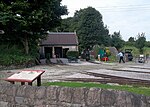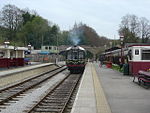National Stone Centre
Museums in DerbyshirePeak DistrictUse British English from February 2023

The National Stone Centre is a museum, an industrial heritage discovery centre and a Site of Special Scientific Interest at Wirksworth, near Matlock Bath in Derbyshire.
Excerpt from the Wikipedia article National Stone Centre (License: CC BY-SA 3.0, Authors, Images).National Stone Centre
Old Lane, Derbyshire Dales
Geographical coordinates (GPS) Address Website External links Nearby Places Show on map
Geographical coordinates (GPS)
| Latitude | Longitude |
|---|---|
| N 53.0936 ° | E -1.5736 ° |
Address
National Stone Centre
Old Lane
DE4 4FP Derbyshire Dales
England, United Kingdom
Open on Google Maps










